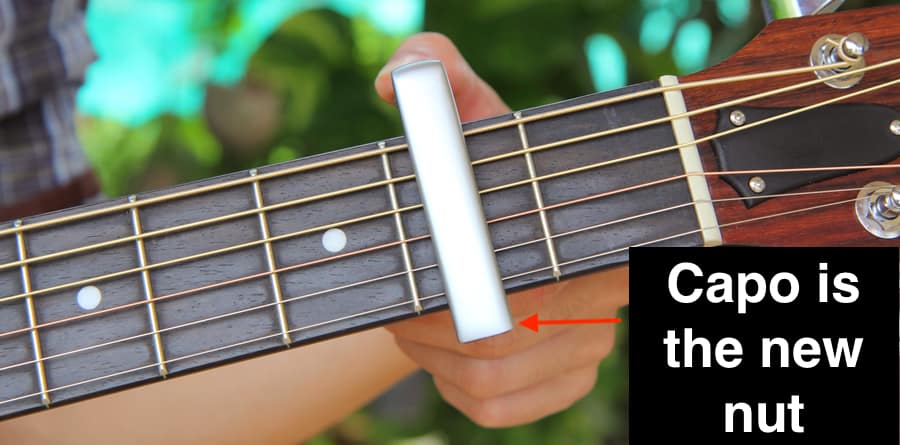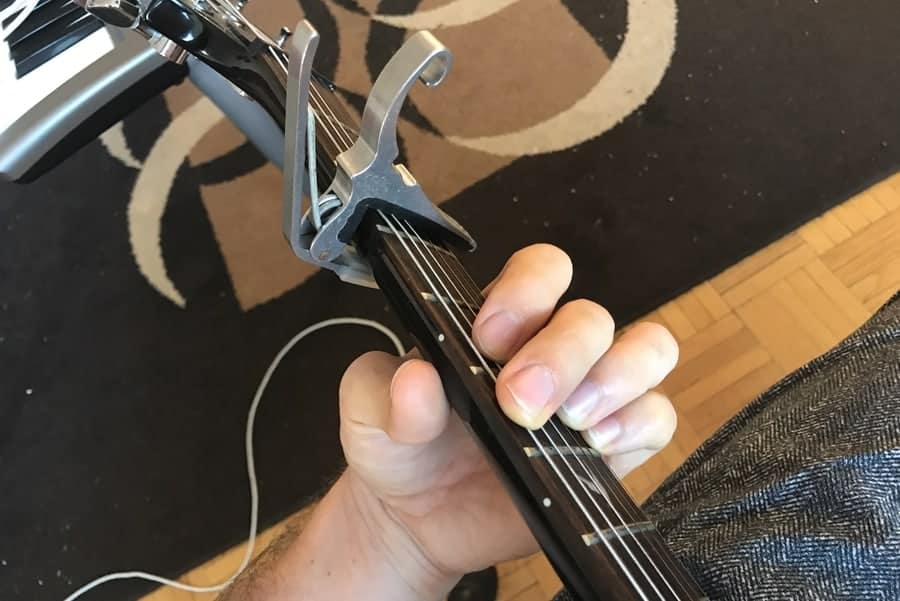As most guitar players know, the guitar is tuned to E, A, D, G, B, and E again, from the lowest to the highest strings, respectively. Some people wonder what key the guitar is tuned to.
But this is one of those questions that, in itself, doesn’t make much sense, because of the fact that the way you play the instrument determines what key you’re in rather than the inherent structure of the instrument itself.
Guitars are typically tuned to standard tuning which includes rising perfect fourths and one major third between the G and B strings. Low E to A, A to D, D to G, and B to high E are all perfect fourths. Additionally, all these notes belong to the key of C Major except you start and end on E.
You could argue this is actually E Phrygian, although, the minor second is missing. The reason why I say it’s in E Phrygian mode is that the 6th string and the 1st string are both E, so one could argue that it’s the tonal center of the notes when tuned to standard tuning.
If you’ve read my other article on whether guitars and pianos are in the same key, you’ll be familiar with what I just mentioned above, the fact that both instruments aren’t necessarily in one key or another.
What key signature and scale you’re playing on the guitar depends mostly on the notes you choose to play, rather than some quality of the instrument in itself.
With all that said, the guitar can be tuned in a variety of different ways in comparison to the piano. Admittedly, the piano can be tuned in different ways as well, however, it’s almost always tuned the same way every single time.
Alternate Tunings Of The Guitar
As I just mentioned, each guitar string can be tuned to a different pitch, to the point where it’s actually possible to tune each string to fit into an entirely new chord, scale, or key signature. I would argue that this is one of the major advantages guitarists have over a piano player.
DADGAD Tuning
D, A, D, G, A, D
For example, it’s not uncommon for acoustic guitarists to tune their guitar into what’s called “DADGAD,” which sounds like the way it’s spelled “Dad-Gad.”
This is a Dsus4 chord, so whenever you strum all of the strings together, it’ll produce a Dsus4 chord without ever fretting any notes.
Dmin9 Tuning
D, F, E, A, C, D
In effect, it’s possible to produce very unique compositions that would be impossible on any other instrument, for example, by tuning the guitar in such a way that each string is part of a particular chord, like a Dmin9 chord.
From here, you can play alternate versions of the chord all over the guitar neck, in a way that isn’t normally possible in standard tuning.
Drop D Tuning
D, A, D, G, B, E
This is arguably the most popular alternate tuning on the guitar. Essentially, it’s the exact same tuning as standard tuning except with the low-E tuned to a D, instead.
What this does is that it makes it very easy to play power chords all over the neck with additional notes added on top, also known as extensions.
Drop D tuning was most popular during the late 1980s and the 1990s, especially with bands like Soundgarden, Alice In Chains, and other bands that employed the use of this lowered tuning and “darker” songs.
For instance, “Them Bones,” from Alice In Chains’ second record, Dirt, uses a riff in Drop D in the very beginning. Drop D power chords are employed all over that song and on the rest of the record, to be honest.
There are countless other examples of songs in Drop D tuning. Admittedly, there are instruments out there that are created in a specific key signature or scale, for instance, harmonicas.
With the exception of a chromatic harmonica, most harmonicas come in a particular key signature, so if you wanted to play in the key of Eb Major on the harmonica, you would actually have to go out and buy a harmonica in that specific key.
This is also why playing the harmonica is a lot easier, in my opinion, because all you have to do is figure out the breathing techniques, in addition to understanding what key you’re in.
Guitar Key Signatures
Some people out there often refer to particular key signatures as “Guitar Key Signatures,” as well, due to their suitability to the guitar’s structure.
For instance, the Key of C Major, A Minor, G Major, E Minor, D Major, and E Major, are some of the easiest keys to play in on the guitar, particularly, C Major, A Minor, G Major, and E Minor.
I would say that the aforementioned key signatures are the easiest to play in, at least for me, especially E Minor due to the fact there is only one sharp in E Minor, F#.
The Key of E Minor is very suitable to improvisation because of this.
In other words, there really is no such thing as a “Guitar Key Signature,” it’s just a scale/key signature that’s more suited to the structure of the instrument.
Using A Capo

Capos like this one are another way of adjusting the key signature and scale of the guitar.
While I rarely use a capo, it can be quite useful because essentially what it does is that it changes the key of the instrument without having to move fingerings and other notes.
In other words, if you put a Capo on the 3rd fret and play an Open G Major chord, you would actually be playing a Bb Major chord but it looks like a G Major chord.
A capo changes the position of the nut, in other words. You can see what this would look like in the image below:

Frankly, I’m not a big fan of using capos, but they definitely have their purpose. Spider capos are pretty cool though because they allow you to play really cool songs like the kind that Antoine Dufour makes who I wrote about in my other article on bass and capos.
Some people swear by them, especially the singer-songwriter types who use the guitar as a way of making simple pop songs, rather than “guitar songs,” where technique and style are the most important.
With that said, capos are a great way to grow accustomed to the most common chords, like G Major, A Minor, C Major, D Major, D Minor, E Minor, and E Major, just to name a few.
When using a capo, all you have to do is change the position of it, for instance, on the 5th fret, and then you can play all of the same chords mentioned above.
But in an entirely different key, without actually changing your fingerings, which you would have to do without the use of a capo.
Other Articles You May Be Interested In
- Why Do Guitar Strings Go Out Of Tune? (The REAL Reason)
- Memorizing Key Signatures (A Detailed Guide With Examples)
- Tuning A Guitar With the Piano (Altered Tunings Included)
- Why Does The B String On The Guitar Sound Out Of Tune?
YouTube Video Tutorial
Conclusion
In conclusion, while the guitar isn’t tuned to a key necessarily – because of the fact that you can play in any key depending on the notes – one could say that it’s in the key of C Major, more specifically, E Phrygian mode, the third mode of C Major, due to the predomination of the E notes.
Anyway, the fact a player can change the tuning of the guitar in so many different ways is one of the greatest aspects of the instrument, and it makes it unparalleled among some of the most common instruments out there, with the exception of the bass guitar, which also does the same thing.


 Written By :
Written By :
